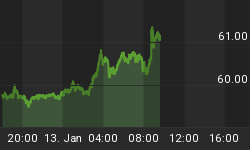An avalanche of worse-than-expected economic and earnings data again put pressure on Wall Street during the past month, resulting in four straight down-weeks and the worst performance of the major US indices for January on record.
"As January goes, so goes the year" is one of the most frequently quoted sayings about seasonal trends in the stock market. With the Dow Jones Industrial Index down by 8.8% and the S&P 500 Index 8.6% lower, the year is not off to a promising start.
Despite frantic actions by the Fed and other central banks to unclog credit markets and restore confidence in the world's financial system, the MSCI World Index and MSCI Emerging Markets Index fell by 8.8% and 6.6% respectively during January.
The performances in the table below are given in local currency terms for different measurement periods ended January 31.

From the highs of late October 2007 until the November 20 lows, mature markets have outperformed developing markets, as shown by the declines of 54.1% for the MSCI World Index and 65.3% for the MSCI Emerging Markets Index. The relative-strength graph below clearly shows this outperformance (i.e. declining trend), but the period since the November lows has witnessed emerging markets reclaiming lost ground (i.e. rising trend).

In local currency terms, the best-performing bourses since the November 20 lows have been Russia (+23.8%), Oslo (+18.8%) and Brazil (+17.7%). However, the two markets still in the red - Helsinki (-2.2%) and France (-0.2%) - have had much less to cheer about.
Considering the month of January, the top three performers were all BRIC countries, namely China (+9.3%), Brazil (+4.7%) and Russia (+2.5%). Although India closed the month on a strong note (up 8.6% during the fourth week), the Bombay Sensex 30 Index still lagged its BRIC counterparts for the month. The year-to-date performances of these countries, together with the MSCI Emerging Markets Index, are shown in the graph below.

Source: StockCharts.com
It should be noted that the Chinese stock market has been closed over the past few days in celebration of the Lunar New Year. It will be interesting to see how this market starts the Year of the Ox on Monday as the chart pattern shows arguably the best base formation of the major market indices. The Shanghai Composite Index (1,991) is also challenging its three-month highs and is within close reach of the roundophobia level of 2,000 for the Shanghai Composite Index.
The gains/declines mentioned above are all in local currency terms. However, converting the movements to US dollar shows a somewhat different picture for the non-dollar countries (see table below). Over the one-month period (US Dollar Index up by 5.8%), the European and emerging-market indices fared considerably worse in dollar terms than in local terms.

With the Russian ruble falling out of bed, the Russian Trading System Index declined by 15.3% in dollar terms over one month, whereas it recorded a gain of 2.5% in local currency terms. (Since the November 20 low, Russia has swung from the first position (+23.8%) in local currency terms to the last place (-4.7%) in dollar terms.
Back to the US stock market, the bar chart below (courtesy of Bespoke) shows the performance of the ten S&P 500 sectors in January. Financials were a large part of the overall declines, as the sector had fallen by 26.5%. On the other hand, Utilities and Health Care were the best-performing sectors, declining by only 0.8% and 1.3% respectively.

Source: Bespoke, January 30, 2009.
Notwithstanding the improvement since the November lows, it remains too early to tell whether a secular low has been recorded. The chart below shows the long-term trend of the S&P 500 Index (green line) together with a simple 12-month rate of change (or momentum) indicator (blue line). Although monthly indicators are of little help when it comes to market timing, they do come in handy for defining the primary trend. An ROC line below zero depicts bear trends as experienced in 1990, 1994, 2000 to 2003, and again since December 2007. Having said that, the level of the indicator is grossly oversold.

Stock markets are still caught between the actions of central banks furiously fending off a total economic meltdown on the one hand, and a worsening economic and corporate picture on the other. Failing stronger market breadth and further evidence of the thawing of the credit markets and the world's financial systems starting to function normally again, investor confidence will probably remain depressed. While I remain distrustful, I am not averse to selective stock picking - picking out the choice morsels, so to speak.
Did you enjoy this post? If so, click here to subscribe to updates to Investment Postcards from Cape Town by e-mail.















